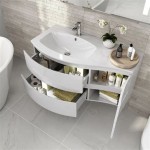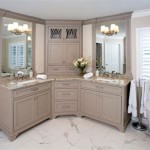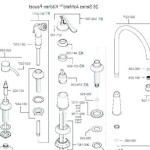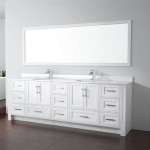The Enduring Appeal and Functionality of Two-Faucet Bathroom Sinks
Two-faucet bathroom sinks, also known as centerset sinks or widespread sinks depending on the configuration, represent a classic design aesthetic that continues to hold relevance in contemporary bathroom design. While single-handle faucets have gained prominence in recent years, the two-faucet system offers a distinct blend of visual appeal, functional control, and installation considerations that warrant careful examination. This article will delve into the various aspects of two-faucet bathroom sinks, exploring their advantages, disadvantages, installation requirements, and design variations, providing a comprehensive understanding of this enduring fixture in the modern bathroom.
The fundamental principle behind a two-faucet system is the separation of hot and cold water controls. Each faucet independently regulates the flow of either hot or cold water, allowing the user to manually adjust the proportion of each to achieve the desired water temperature. This differs from single-handle faucets, which typically mix hot and cold water within the faucet body before dispensing it through a single spout. The historical prevalence of two-faucet systems stems from early plumbing technology and a more straightforward manufacturing process compared to the complex mixing mechanisms required for single-handle designs.
The aesthetic impact of a two-faucet sink is often a significant factor in its selection. The symmetry and balance created by two separate faucets flanking a central spout can contribute to a sense of formality and elegance. This design choice resonates particularly well with traditional bathroom styles but can also be adapted to more contemporary designs through the selection of modern faucet styles and finishes. The visual separation further allows for the incorporation of different materials and textures, enhancing the overall design statement of the sink area.
Beyond aesthetics, the two-faucet configuration offers a degree of functional control that appeals to some users. The precise adjustment of hot and cold water flow allows for a fine-tuned control over water temperature, potentially offering a more personalized experience compared to the sometimes less granular control offered by single-handle mixing mechanisms. This precise control can be particularly useful in situations where temperature sensitivity is a concern, such as for individuals with sensitive skin.
Advantages of Two-Faucet Bathroom Sinks
One of the most significant advantages of two-faucet bathroom sinks lies in their aesthetic versatility. The separation of hot and cold water controls provides a visual balance that lends itself well to both traditional and modern bathroom designs. In traditional settings, ornate faucet designs with porcelain handles can enhance the classic aesthetic. Conversely, sleek, minimalist faucet designs with clean lines can complement a contemporary bathroom style. The ability to mix and match faucet styles and finishes allows for a high degree of design customization, enabling homeowners to create a unique and personalized bathroom space.
The independent control offered by two-faucet systems is another crucial advantage. Users can adjust the hot and cold water flow independently, offering a more precise temperature control compared to some single-handle faucets. This can be particularly beneficial for individuals who prefer specific water temperatures for different tasks, such as washing hands or shaving. Furthermore, in situations where water pressure is inconsistent, the independent controls allow for more precise management of the water flow, mitigating the impact of pressure fluctuations on the water temperature.
Durability and ease of repair are often cited as advantages of two-faucet systems. Due to their simpler internal mechanisms compared to single-handle mixing faucets, two-faucet systems can be inherently more reliable and less prone to mechanical failure. Individual faucet components, such as valves and handles, can be replaced independently, simplifying repairs and potentially extending the lifespan of the faucet system. This can translate to lower maintenance costs over the long term.
Disadvantages of Two-Faucet Bathroom Sinks
Despite their advantages, two-faucet bathroom sinks also present certain drawbacks that should be considered during the selection process. One potential disadvantage is the lack of a single-handed operation. Unlike single-handle faucets, which can be easily operated with one hand, two-faucet systems require the use of both hands to adjust the water temperature. This can be inconvenient for individuals with limited mobility or when performing tasks that require the use of one hand.
The potential for water wastage is another concern associated with two-faucet systems. Users may inadvertently waste water while adjusting the hot and cold water flow to achieve the desired temperature. This contrasts with single-handle faucets, which often provide a more intuitive and efficient mixing process, reducing the amount of water wasted during temperature adjustment. However, this disadvantage can be mitigated by being mindful of water usage habits and taking steps to minimize unnecessary water flow.
Installation complexity can also be a factor when considering two-faucet bathroom sinks. The installation process typically involves connecting separate hot and cold water supply lines to each individual faucet, potentially requiring more plumbing expertise and time compared to installing a single-handle faucet. This complexity can translate to higher installation costs if professional plumbing services are required. However, with careful planning and adherence to installation instructions, many homeowners can successfully install two-faucet systems themselves.
Installation and Design Considerations
The installation of a two-faucet bathroom sink requires careful planning and attention to detail. Typically, the sink itself will have three holes: one for the hot water faucet, one for the cold water faucet, and one for the spout. The distance between the faucet holes is a critical measurement, often referred to as the "centerset" or "widespread" configuration. Centerset faucets typically have a 4-inch measurement between the hot and cold water inlets, while widespread faucets usually have an 8-inch measurement or greater. It is essential to select a faucet set that matches the hole configuration of the sink to ensure a proper fit.
The water supply lines must be properly connected to the hot and cold water inlets of the faucets. Flexible supply lines are often recommended to simplify the installation process and accommodate minor variations in plumbing alignment. It is crucial to ensure that the connections are tight and leak-free to prevent water damage. Teflon tape can be used on threaded connections to create a watertight seal. Furthermore, shut-off valves should be installed on the water supply lines to allow for easy maintenance and repairs without having to shut off the water supply to the entire house.
The design of the two-faucet system should complement the overall aesthetic of the bathroom. A wide range of faucet styles and finishes are available, allowing homeowners to customize the look of their sink area. Traditional bathrooms often feature ornate faucets with porcelain handles and polished brass or chrome finishes. Contemporary bathrooms may incorporate sleek, minimalist faucets with clean lines and brushed nickel or matte black finishes. The selection of a complementary drain and other bathroom accessories can further enhance the overall design cohesion.
The choice of sink material is another important consideration. Porcelain sinks are a classic and durable option that is easy to clean and maintain. Vitreous china sinks offer a similar aesthetic but may be more resistant to chipping and staining. Stone sinks, such as marble or granite, can add a touch of luxury and elegance to the bathroom. However, stone sinks may require more specialized cleaning and maintenance. The size and shape of the sink should also be considered to ensure that it fits comfortably within the available space and meets the functional needs of the user.
Ergonomics play a crucial role in the overall user experience of a two-faucet bathroom sink. The height of the faucets and spout should be comfortable for users of different heights. The reach of the spout should be sufficient to allow for easy access to the water without having to lean too far forward. The handles should be easy to grip and turn, even with wet hands. Considering these ergonomic factors can significantly enhance the functionality and usability of the sink area.
In conclusion, two-faucet bathroom sinks offer a blend of aesthetic appeal, functional control, and installation considerations. While single-handle faucets have gained popularity, the distinct advantages of two-faucet systems, particularly their design versatility and potential for precise temperature control, ensure their continued relevance in bathroom design. Careful consideration of the advantages and disadvantages, along with proper installation and design, will ultimately determine the suitability of a two-faucet system for a particular bathroom space.

Pin On For The Home

One Sink Two Faucets Design Ideas

One Sink Two Faucets Design Ideas

Scarabeo 8031 R 100b Con Blk Console Bathroom Sink Teorema Nameek S

One Sink Two Faucet Modern Bathroom Large Design

One Sink Two Faucets Design Ideas

Double Faucet Trough Sink Ideas Photos Houzz

Cerastyle 080500 U Bathroom Sink Pinto Nameek S

One Sink Two Faucets Design Ideas

New Design Stone Resin Wall Hung Bathroom Sinks Double Wash Basin Sink With Two Faucets China Made In Com







